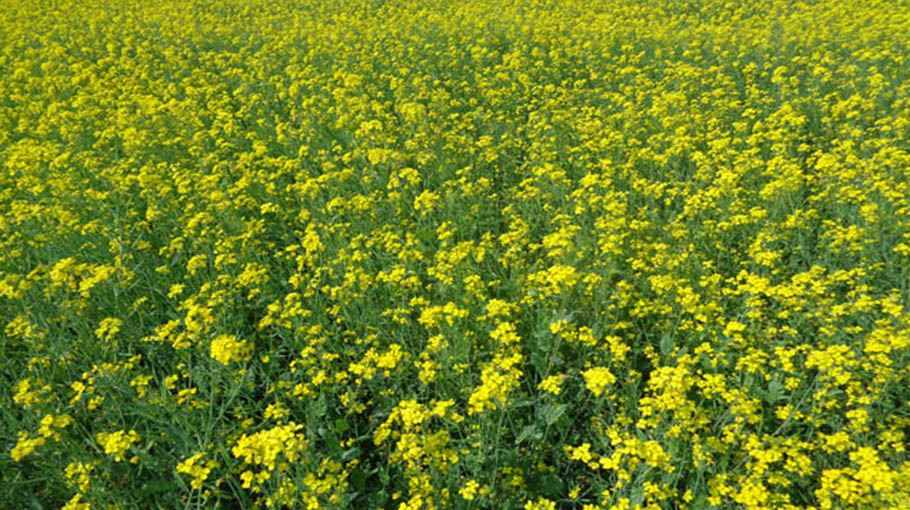Bumper mustard yield likely in Pabna, farmers expect profit

Mustard is being cultivated in vast fields of Bara Upazila of Pabna. As far as the eye can see, only mustard flowers are in the field. The farmer's field is full of yellow. According to Upazila Agriculture Office, although the target of mustard cultivation is 3 thousand 445 hectares of land in Bera upazila including Char area, it has been cultivated in 3 thousand 580 hectares of land. Due to the high price and demand of mustard, favorable environment and low cost of cultivation, the mustard farmers of Bera have cultivated more mustard in 135 hectares of land than the target this season.
50% of the total mustard cultivation of the upazila is done in the eastern side of the flood control dam along with the grazing area. If the weather is favorable, the mustard growers along with the agriculture officials are expecting a bumper crop of mustard this year.
Zainal Haque, a farmer of Chakla village of the upazila, said that he has cultivated 14 varieties of mustard on 5 bigha of land this season. Chhattar Ali, a farmer of Dhalla Char Union, said that the cost of mustard cultivation is very low compared to other crops. Fertilizer, irrigation and pesticide application in mustard field is very less. Mustard cultivation starts at the beginning of November. It takes 75 to 90 days to ripen. It's middle time now. Flat and relatively high land is suitable for mustard cultivation. Mustard seeds should be sown after light tillage, application of fertilizers. After 3 to 4 weeks of sprouting from seeds, sprinkling a small amount of fertilizer on the top gives good yield easily. Farmers of this region are getting more interested in mustard cultivation day by day due to more profit with relatively less effort.
Anshar Ali, a farmer of Char Nakalia village of Haturia Nakalia union of upazila, said, I cultivated Tori-7 variety of mustard on 3 bigha land, the mustard field is covered with flowers. Hope the yield will be good. Even after cultivating mustard, paddy can be cultivated, as this crop can be raised at home in a short period of time, we cultivate mustard because of that.
Agriculture Extension Officer of Upazila Agriculture Extension Department, Nur e Alam, said that the Upazila Agriculture Extension Department has provided free seeds and fertilizers to about 2,600 farmers this season to create interest in winter crop cultivation including mustard. Upazila Agriculture Office along with Agriculture Officer, Assistant Agriculture Officer are constantly advising and solving problems of farmers. There is a possibility of production of 4 thousand 496 metric tons of mustard in the current season. This time the farmer has cultivated mustard on much more land than the target of mustard cultivation. Mustard production has increased as expected this season due to good yield and high market price of mustard last year.
When asked about the damage to mustard plants and flowers due to fog, Upazila Assistant Agriculture Officer Yusub Ali said that the current weather is good for mustard cultivation, a little fog can not harm the mustard flowers, but if there is fog for several days, then the mustard flowers will be damaged. There is a possibility of damage.
After mustard cultivation, the fertility of the land, productivity and disease resistance of the crop increases. This winter crop serves as a support for the next crop of mustard. As the weather is favorable for mustard cultivation, the agriculture department is expecting a bumper crop of mustard in the upazila this season. The Agriculture Office also informed that in the current season Bari Sarisa-14, 15 and newly developed high yielding varieties Bari-17 and Tori-7 have been cultivated in 3 thousand 580 hectares of land in the upazila. Field level agriculture officers are providing advice to the farmers round the clock.
Talking to the mustard farmers, it is known that sufficient amount of flowers have come on the mustard plant, if the weather disaster does not happen, they expect that the mustard yield will be 6 to 6 and a half mounds per bigha in the current season. Mustard cultivation is very beneficial for subsequent boor rice cultivation. After mustard cultivation, mustard plant is also used as fuel. Mustard cultivation costs 2,500 to 3,000 taka per bigha. If the yield is good, 6 to 6 and a half mounds of mustard can be obtained from one bigha of land. Currently, the market price of mustard per mound is 3800 to 4000 taka. In this case, about 20 to 21 thousand taka will be profited from every bigha of land excluding all expenses. Due to the increase in mustard demand and market price, the farmers of the area have turned to mustard cultivation in addition to vegetable cultivation, as a result, mustard cultivation has slightly increased in the current season.
Boro paddy can be cultivated in the land only after mustard cultivation. It reduces the use of fertilizers in the land, mustard leaves and roots act as green manure and also helps in increasing the yield of Boro rice.
Vast fields are covered with yellow mustard flowers. The intoxicating smell of mustard flowers attracts everyone. Mustard yellow flower ceremony in the field. Millions of bees are extracting honey from these flowers. As there is a large amount of mustard cultivation in the upazila, the beekeepers are busy collecting honey at this important time of the year by placing their boxes next to the mustard field, in the fields. A suitable source of abundant honey is the mustard flower extract.
Horizontal double mustard flowers bring variety to crop fields. Farmers are smiling as bumper crop this year.
If the weather is favorable, the upazila’s mustard production will exceed the target in the current season.




